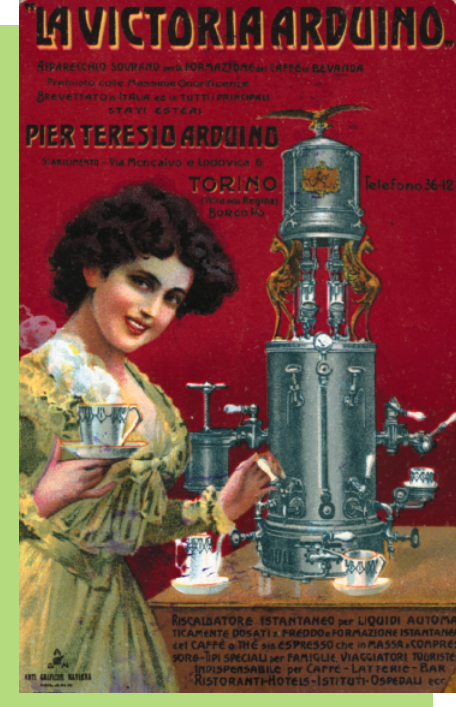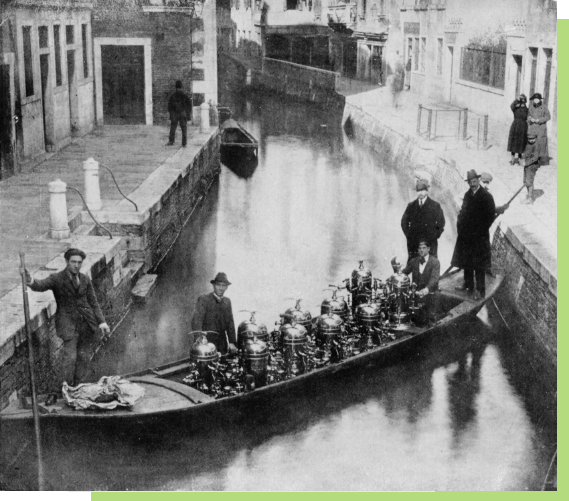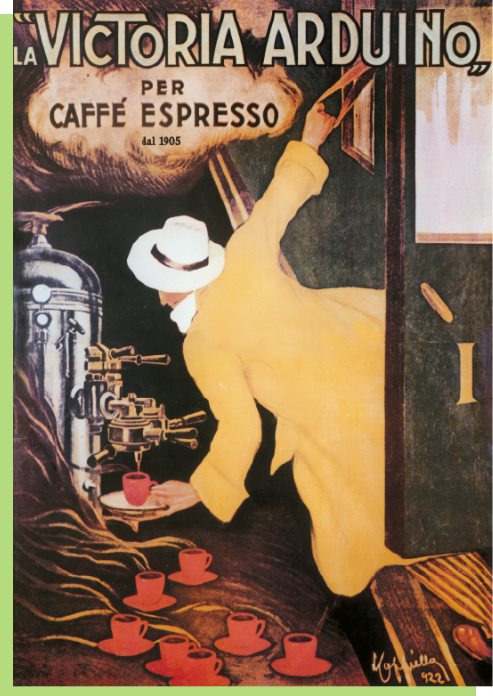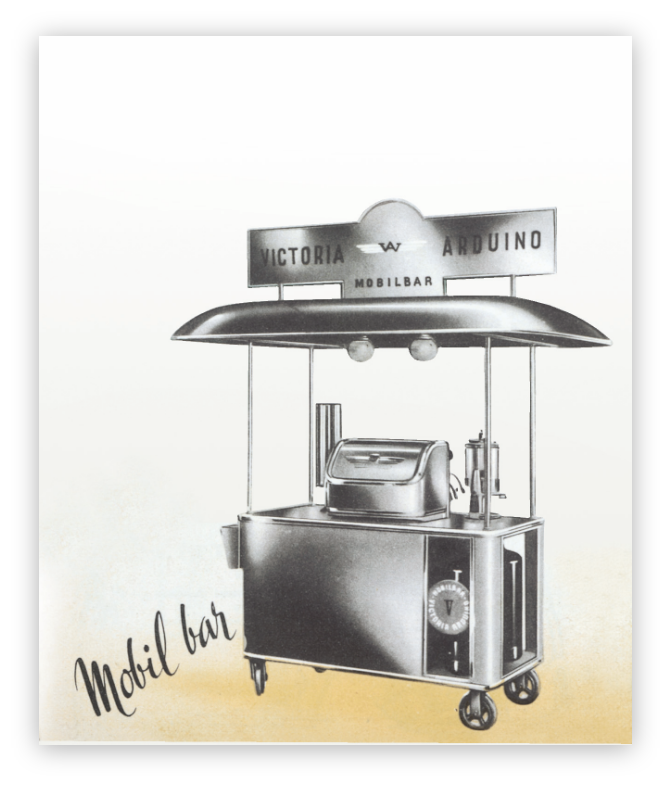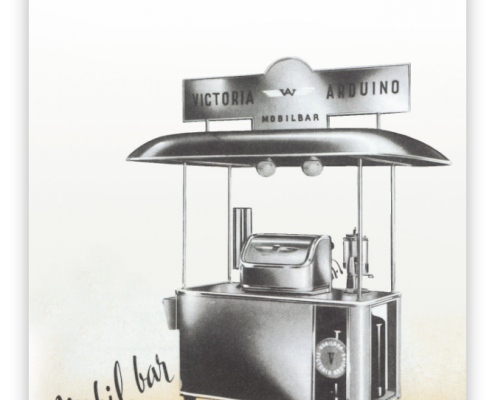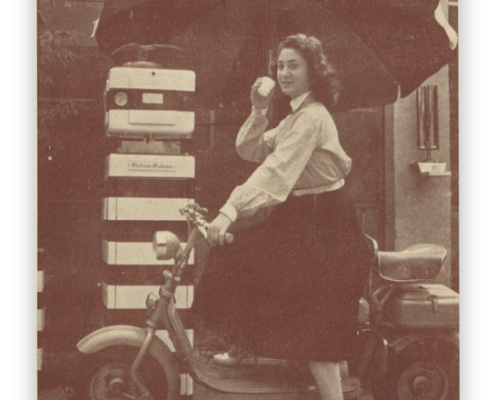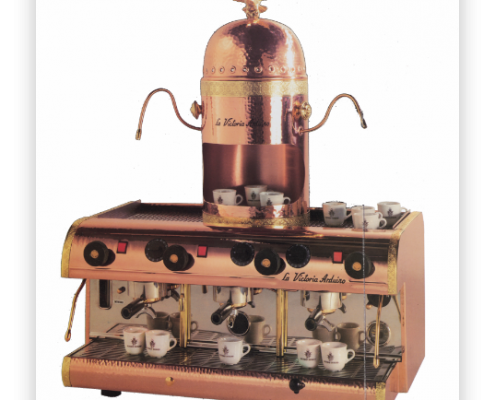1905
VICTORIA. THE FIRST MACHINE

Young Pier Teresio had to immediately acknowledge that the world of café shops and bars was changing just like the machines were becoming old school. He proposed to create a new type of device, a machine that ensured the quick, easy and secure way to supply coffee. He also understood that the boiler needed to be replaced in order to maximize efficiency. Using the technical experience cultivated at school and the confidence obtained with locomotives during his military time (he worked closely with steam boilers), he started working on a concept machine.
1910
1910
DOUBLE TAP SYSTEM
SISTEMA DI RUBINETTO DOPPIO
In 1910 Pier Teresio Arduino dedicated himself to a new project: this he didn't want to recreate just a machine that heats the already prepared coffee, but a real machine for the instant preparation of coffee. The new device had on one side, the portafilter handle with a fast hook system for the coffee preparation, and on the other side a filtered container filled with ground coffee that could be pressed and squeezed until the infusion occurred through a screw rod. In 1910 the patent of the creation with number 108873 with registration n. 325/195910 was confirmed.
Nel 1910 Pier Teresio Arduino si dedicò al suo miglioramento ed al progetto di un nuovo apparecchio: era questa volta non più una macchina atta al solo riscaldamento del caffè già preparato in precedenza, ma una vera macchina per la preparazione istantanea della bevanda. Il nuovo apparecchio, che naturalmente sfruttava tutta l’esperienza del precedente, aveva da un lato la maniglia portafiltro con attacco rapido per la preparazione del caffè espresso e dall’altro un recipiente con filtro contenente la polvere di caffè che poteva essere compressa e spremuta, alla fine dell’infusione, a mezzo di un pistoncino a vite per cavarne tutto l’aroma. La sua nuova creazione è stata brevettata nel 1910 il numero 108873 con registrazione n. 325/15910.
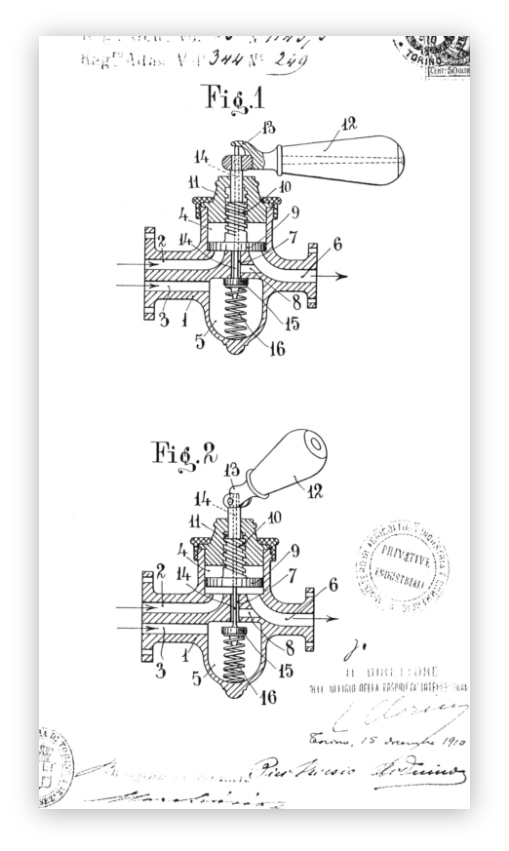

1920
1920
FAMILY TYPE MACHINE
LA MACCHINA TIPO FAMIGLIA
Among the emerging models during this period by Victoria Arduino, there was a machine called 'family-type.' It was completely chrome, with electrical functions, able to make from one to six coffees at the same time. Let's say it was a real beauty and efficient at the same time.The machine was only 30 cm in height, and when the steam of the boiler reached the optimal pressure, through the opening of the tap placed on top, the water was pushed outright through the ground coffee.
Fra i modelli di macchina sfornati in questo periodo dalla Victoria Arduino c’era quello denominato ‘tipo famiglia’, completamente cromato, a funzionamento elettrico, ch’era un vero gioiello di tecnica e d’estetica e che poteva preparare da una a sei tazze di caffè. La macchina era alta appena 30 cm e quando si otteneva in caldaia la pressione ottimale del vapore, aprendo il rubinetto posto alla sommità, l’acqua veniva spinta fuori attraverso la polvere di caffè.
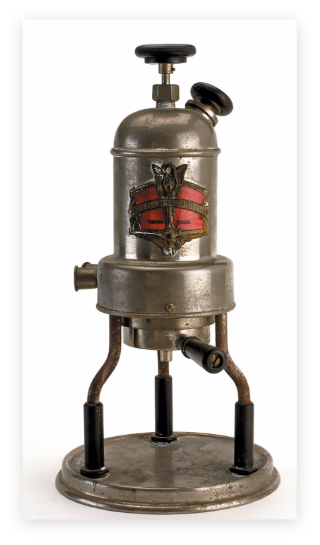

1922
1922
THE MURAL MACHINE
LA MACCHINA MURALE
The 'mural machine' is genuinely original. Called 'mural' because bolted to the walls of café shops, the device supplied water directly from the aqueduct through the thrust of the piston pump, that switched on through a manual lever sending the correct quantity of water to the heater (electrical, gas, or other.)
La ‘macchina murale’ era veramente originale: veniva imbullonata al muro del locale ed era alimentata con acqua che proveniva direttamente dalla tubazione dell’acquedotto mediante la spinta di una pompa a stantuffo, azionata mediante una leva manuale, che ne inviava la giusta quantità al riscaldatore, che poteva essere elettrico o a gas o d’altro tipo. Questa macchina avrà successivamente un’evoluzione tale che prevedeva a vista sul muro del bar, dietro al bancone di mescita, i soli gruppi portafiltro, con la macchina vera e propria installata dietro la parete in locale attiguo.
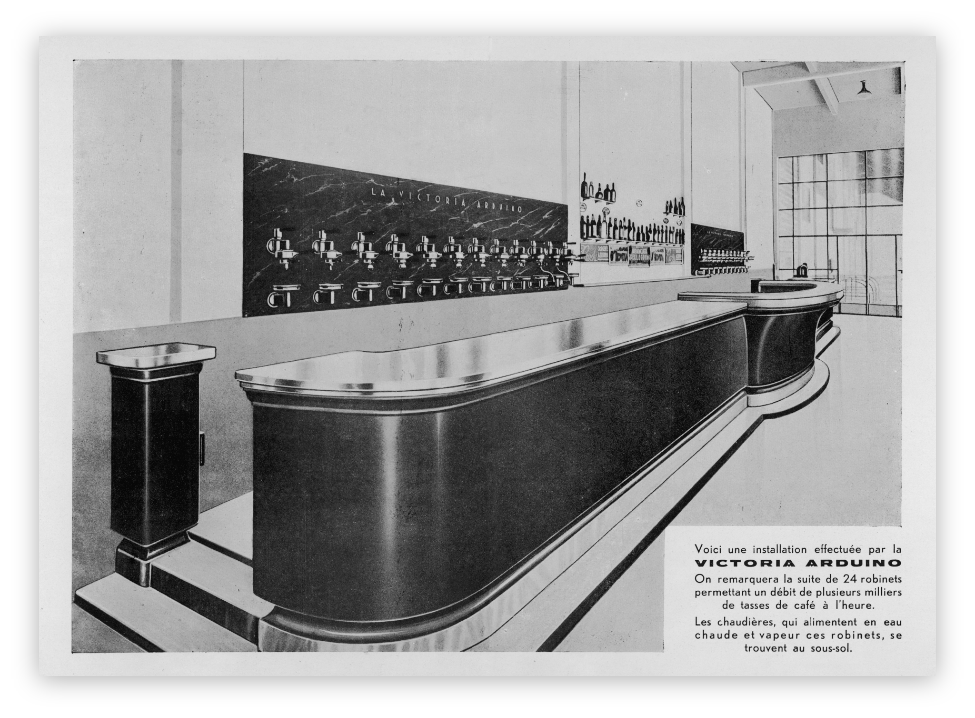

1927
1927
THE MACHINE WITH A PUMP
LA MACCHINA CON POMPA
In 1926 Victoria Arduino presented the request for industrial property right released in 1927. The right allowed the company to patent a new system able to use high-temperature water to brew the coffee instead of steam. To try out the patent, Victoria Arduino constructed a two-group machine with each group having a manual pump that, through a piston, pushed the water at the ideal temperature, into the ground coffee.
Nel 1926 la Victoria Arduino aveva presentato domanda di privativa industriale, il cui attestato venne rilasciato nel 1927, per un sistema atto ad ottenere il caffè usando non più il vapore ma l’acqua a temperatura inferiore a quella di ebollizione. Per dare pratica realizzazione a questo brevetto fu costruita una macchina a due gruppi, ciascuno dei quali era equipaggiato con una pompa manuale che tramite un pistone forzava il passaggio dell’acqua, fornita al gruppo a temperatura inferiore a quella d’ebollizione, attraverso il caffè.
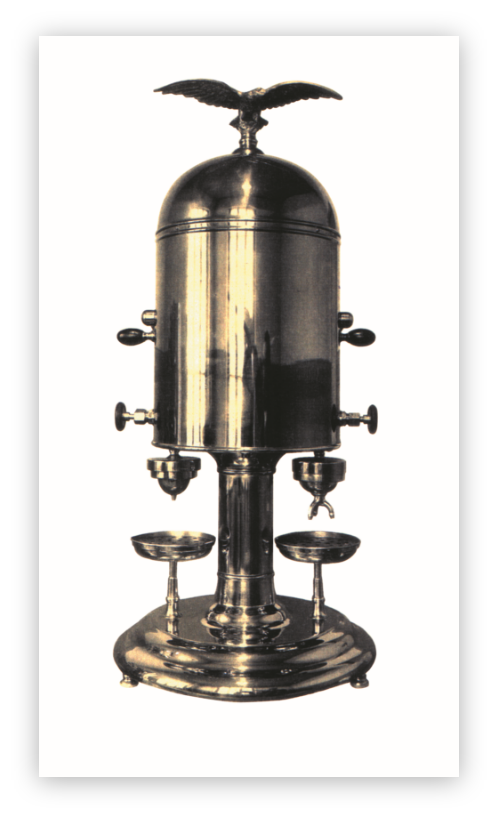

1946
1927
WAT SERIES. LUIGI CACCIA DOMINIONI
LA MACCHINA CON POMPA
In 1946, Victoria Arduino collaborated with Luigi Caccia Dominioni, a famous international architect and designer. The architect created the 'WAT series', which was included the models 'Unovat' with one group, 'Supervat,' and Watt with four groups.
Nel 1926 la Victoria Arduino aveva presentato domanda di privativa industriale, il cui attestato venne rilasciato nel 1927, per un sistema atto ad ottenere il caffè usando non più il vapore ma l’acqua a temperatura inferiore a quella di ebollizione. Per dare pratica realizzazione a questo brevetto fu costruita una macchina a due gruppi, ciascuno dei quali era equipaggiato con una pompa manuale che tramite un pistone forzava il passaggio dell’acqua, fornita al gruppo a temperatura inferiore a quella d’ebollizione, attraverso il caffè.
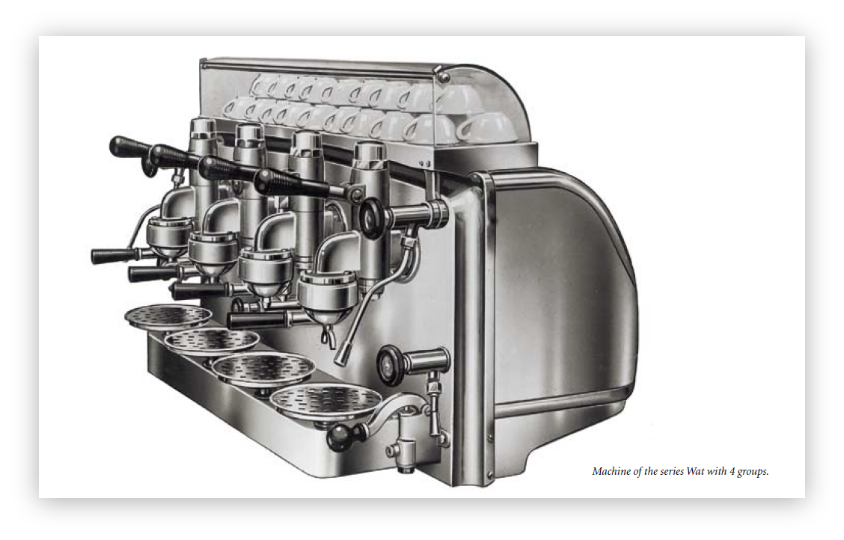

1951
1922
MOBIL BAR
LA MACCHINA MURALE
In 1951 Victoria Arduino also made a transportable stand named 'Carrel bar', with a gas boiler chamber made precisely for traveling street baristas. This mobile bar became an essential part of events, exhibitions also found on the sidewalks of central train stations.
La ‘macchina murale’ era veramente originale: veniva imbullonata al muro del locale ed era alimentata con acqua che proveniva direttamente dalla tubazione dell’acquedotto mediante la spinta di una pompa a stantuffo, azionata mediante una leva manuale, che ne inviava la giusta quantità al riscaldatore, che poteva essere elettrico o a gas o d’altro tipo. Questa macchina avrà successivamente un’evoluzione tale che prevedeva a vista sul muro del bar, dietro al bancone di mescita, i soli gruppi portafiltro, con la macchina vera e propria installata dietro la parete in locale attiguo.
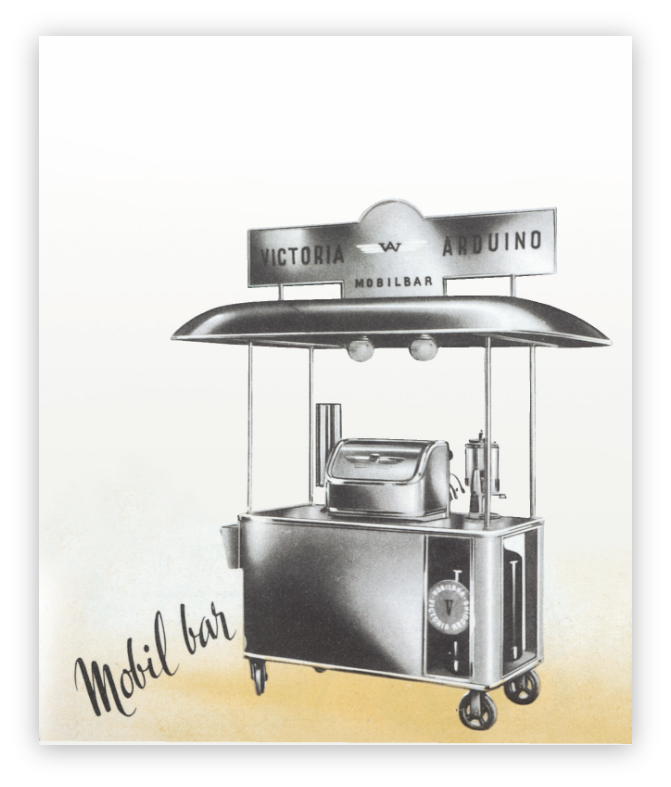

1953
1910
THE AUTOMATIC MACHINE
SISTEMA DI RUBINETTO DOPPIO
In the 1950s' Victoria Arduino created its first automatic token coffee machine, kind of like those machines we often see everywhere nowadays.
Nel 1910 Pier Teresio Arduino si dedicò al suo miglioramento ed al progetto di un nuovo apparecchio: era questa volta non più una macchina atta al solo riscaldamento del caffè già preparato in precedenza, ma una vera macchina per la preparazione istantanea della bevanda. Il nuovo apparecchio, che naturalmente sfruttava tutta l’esperienza del precedente, aveva da un lato la maniglia portafiltro con attacco rapido per la preparazione del caffè espresso e dall’altro un recipiente con filtro contenente la polvere di caffè che poteva essere compressa e spremuta, alla fine dell’infusione, a mezzo di un pistoncino a vite per cavarne tutto l’aroma. La sua nuova creazione è stata brevettata nel 1910 il numero 108873 con registrazione n. 325/15910.
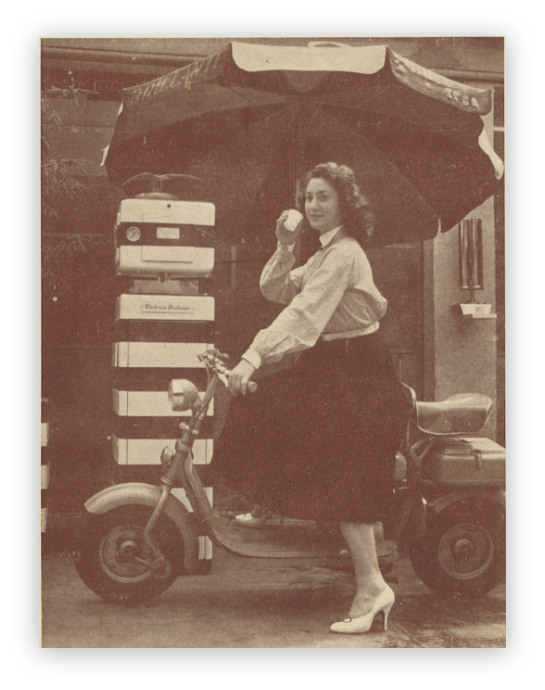

1968
1910
VENUS SERIES
SISTEMA DI RUBINETTO DOPPIO
At the end of the 1960s', the production of vertical machines started to be appreciated again. It was during this era that the new models 'Venus' and 'Venus family' we created and still today have an important production and success. The 'Venus family' was distinct for its vibration pump.
Nel 1910 Pier Teresio Arduino si dedicò al suo miglioramento ed al progetto di un nuovo apparecchio: era questa volta non più una macchina atta al solo riscaldamento del caffè già preparato in precedenza, ma una vera macchina per la preparazione istantanea della bevanda. Il nuovo apparecchio, che naturalmente sfruttava tutta l’esperienza del precedente, aveva da un lato la maniglia portafiltro con attacco rapido per la preparazione del caffè espresso e dall’altro un recipiente con filtro contenente la polvere di caffè che poteva essere compressa e spremuta, alla fine dell’infusione, a mezzo di un pistoncino a vite per cavarne tutto l’aroma. La sua nuova creazione è stata brevettata nel 1910 il numero 108873 con registrazione n. 325/15910.
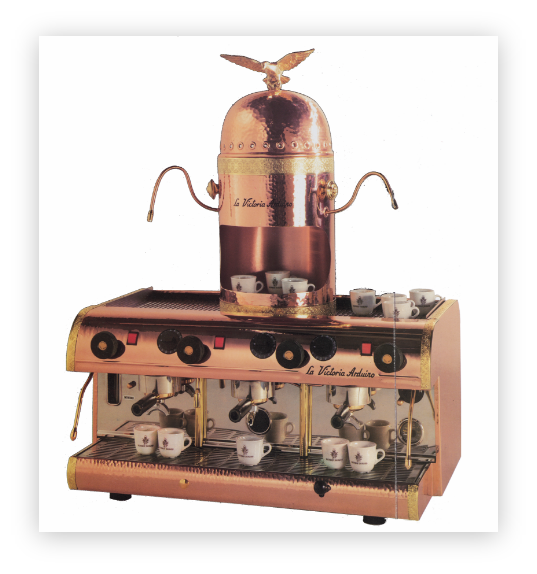

2001
1922
LA MACCHINA MURALE
NUOVA SIMONELLI ACQUIRED THE VICTORIA ARDUINO BRAND
At the end of 2001, Michele Mercandelli, owner of the company, decided to hand over Victoria Arduino to Nuova Simonelli.The two companies were already collaborating for different years, so the acquisition was finalized for this reason. It is thanks to this cooperation that the project started by Pier Teresio Arduino in the first 1900s' began to flourish. He desired a bigger picture of the company, not only selling coffee machines but integrating philosophical and literary theories and spread the coffee culture worldwide.
La ‘macchina murale’ era veramente originale: veniva imbullonata al muro del locale ed era alimentata con acqua che proveniva direttamente dalla tubazione dell’acquedotto mediante la spinta di una pompa a stantuffo, azionata mediante una leva manuale, che ne inviava la giusta quantità al riscaldatore, che poteva essere elettrico o a gas o d’altro tipo. Questa macchina avrà successivamente un’evoluzione tale che prevedeva a vista sul muro del bar, dietro al bancone di mescita, i soli gruppi portafiltro, con la macchina vera e propria installata dietro la parete in locale attiguo.
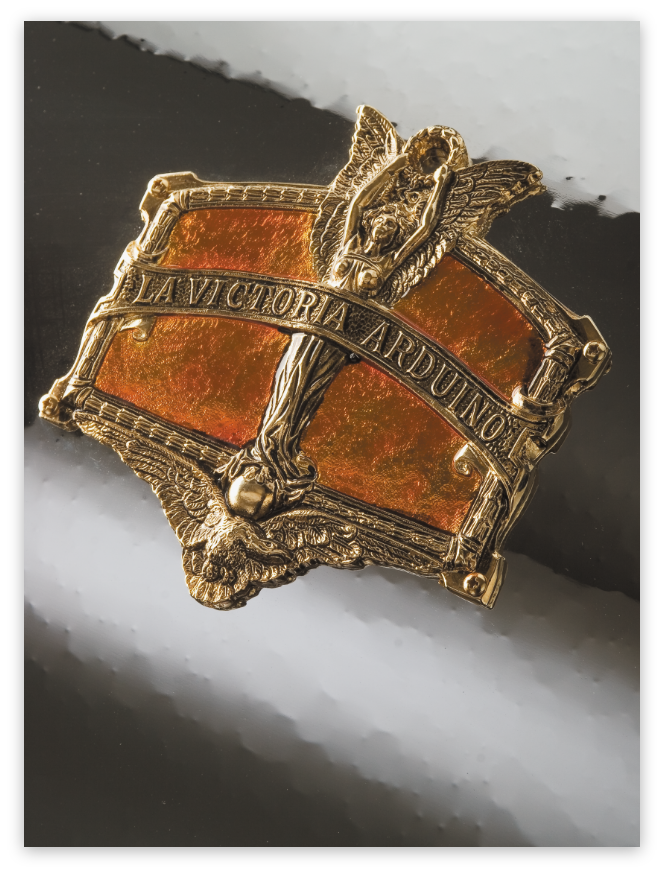

2005
1920
VENUS CENTURY
LA MACCHINA TIPO FAMIGLIA
In 2005, on the occasion of its 100th anniversary, Victoria Arduino launched a collection piece named 'Venus Century.' It was a vertical espresso coffee machine with minimal styling and made only 100 pieces. The machine numbered '000' was donated to the then Pope Benedict XVI that was a coffee lover himself.
Fra i modelli di macchina sfornati in questo periodo dalla Victoria Arduino c’era quello denominato ‘tipo famiglia’, completamente cromato, a funzionamento elettrico, ch’era un vero gioiello di tecnica e d’estetica e che poteva preparare da una a sei tazze di caffè. La macchina era alta appena 30 cm e quando si otteneva in caldaia la pressione ottimale del vapore, aprendo il rubinetto posto alla sommità, l’acqua veniva spinta fuori attraverso la polvere di caffè.
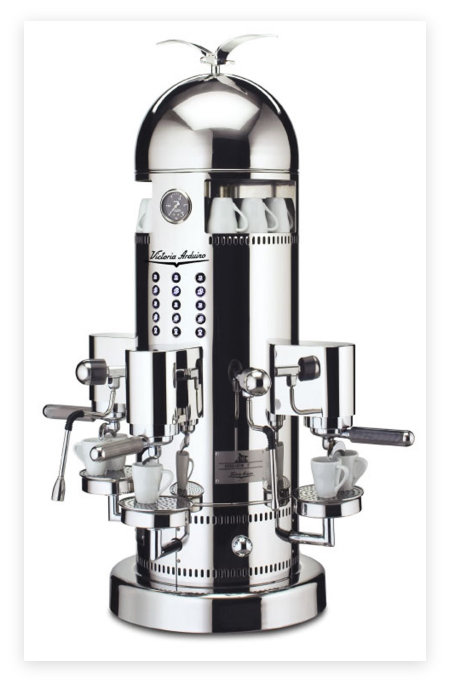

2013
1920
LAUNCH OF THE MYTHOS ONE
LA MACCHINA TIPO FAMIGLIA
Mythos: the new generation on-demand grinders with advanced technology and thoughtful details that satisfy even the most demanding barista.
Fra i modelli di macchina sfornati in questo periodo dalla Victoria Arduino c’era quello denominato ‘tipo famiglia’, completamente cromato, a funzionamento elettrico, ch’era un vero gioiello di tecnica e d’estetica e che poteva preparare da una a sei tazze di caffè. La macchina era alta appena 30 cm e quando si otteneva in caldaia la pressione ottimale del vapore, aprendo il rubinetto posto alla sommità, l’acqua veniva spinta fuori attraverso la polvere di caffè.
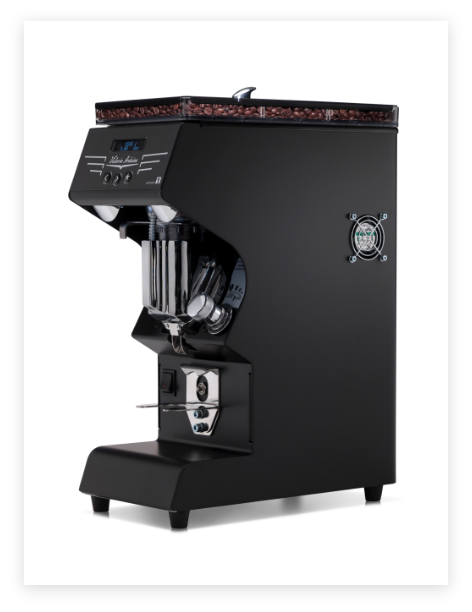

2014
1927
LAUNCH OF THE VA 388 BLACK EAGLE
LA MACCHINA CON POMPA
In 2015, the world saw for the first time the VA388 Black Eagle, the top tier machine of the range, with high-end technology that lets the barista fully embrace the uniqueness of specialty coffee.To build this superb machine, the company put together a team of qualified researchers, professionals, designers, and high-level baristas.The result was the creation of an eye-catching coffee machine that became the center attraction of every café counter it adorns.
Nel 1926 la Victoria Arduino aveva presentato domanda di privativa industriale, il cui attestato venne rilasciato nel 1927, per un sistema atto ad ottenere il caffè usando non più il vapore ma l’acqua a temperatura inferiore a quella di ebollizione. Per dare pratica realizzazione a questo brevetto fu costruita una macchina a due gruppi, ciascuno dei quali era equipaggiato con una pompa manuale che tramite un pistone forzava il passaggio dell’acqua, fornita al gruppo a temperatura inferiore a quella d’ebollizione, attraverso il caffè.
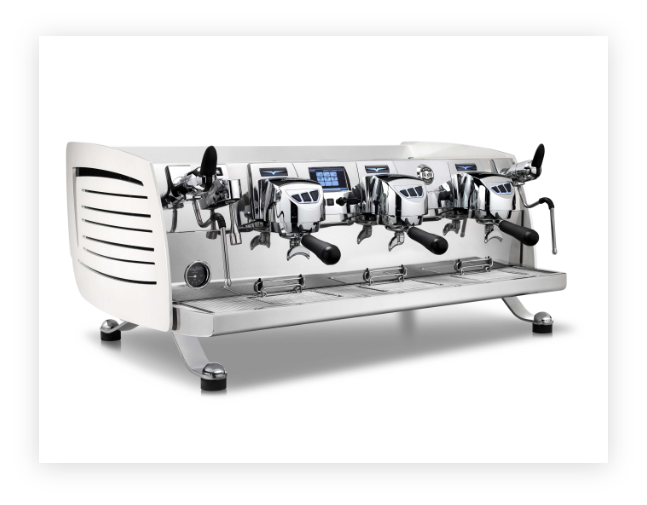

2015
1927
LA MACCHINA CON POMPA
The best baristas worldwide deserve the best equipment to show their top performances on a global scale. From 2015, VA388 is the official coffee machine used in the World Barista Championship.
VA 388 BECOMES THE OFFICIAL MACHINE OF THE WORLD BARISTA CHAMPIONSHIP
Nel 1926 la Victoria Arduino aveva presentato domanda di privativa industriale, il cui attestato venne rilasciato nel 1927, per un sistema atto ad ottenere il caffè usando non più il vapore ma l’acqua a temperatura inferiore a quella di ebollizione. Per dare pratica realizzazione a questo brevetto fu costruita una macchina a due gruppi, ciascuno dei quali era equipaggiato con una pompa manuale che tramite un pistone forzava il passaggio dell’acqua, fornita al gruppo a temperatura inferiore a quella d’ebollizione, attraverso il caffè.
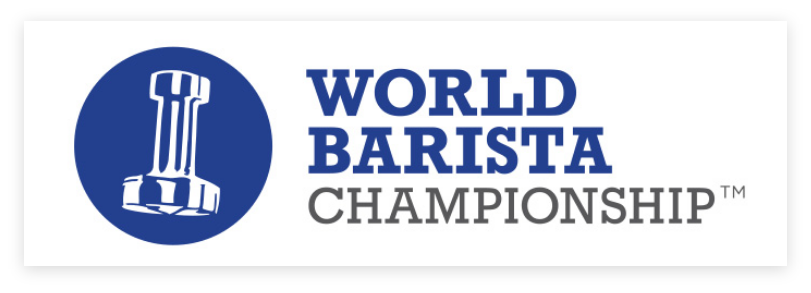

2019
1920
FUTURE BEGINS

 https://victoriaarduino.com/wp-content/uploads/layerslider/History-slider-en/timeline1.png
445
466
Sara Giacomelli
https://victoriaarduino.com/wp-content/uploads/2020/03/Logo.png
Sara Giacomelli2020-07-09 09:45:082020-07-16 10:53:251905
https://victoriaarduino.com/wp-content/uploads/layerslider/History-slider-en/timeline1.png
445
466
Sara Giacomelli
https://victoriaarduino.com/wp-content/uploads/2020/03/Logo.png
Sara Giacomelli2020-07-09 09:45:082020-07-16 10:53:251905
